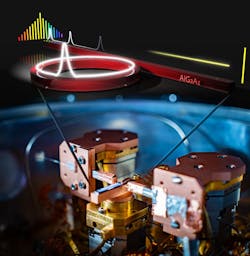Laser frequency comb filters let only evenly spaced, sharply defined frequencies of light pass through. The uniformly spaced frequencies resemble the teeth of a comb, hence the name. They’re used to measure the frequency and time with great precision.
Researchers at the National Institute of Standards and Technology (NIST) and the University of California at Santa Barbara (UCSB), are working on improving the combs by shrinking them to fit on a chip. The proposed microcombs will advance time and frequency measurements by improving and extending the capabilities of comb fitters.
At the heart of these frequency microcombs is an optical microresonator, a ring-shaped device about 0.02 mm in diameter. An external laser sends its beams into the ring, where they race around in circles thousands of times as they build in intensity. Microcombs, often made of glass or silicon nitride, typically require an amplifier for the external laser light, which can make the comb complex, cumbersome and costly to produce.
The NIST team is using microcombs created from the semiconductor aluminum gallium arsenide, which give them two distinct advantages. They operate at such low power (1% of what conventional combs need) that the laser does not need an amplifier. Plus, they can be controlled to create an extraordinarily steady set of frequencies, exactly what is needed to use the microchip comb to measure frequencies with extraordinary precision.
When developing the microcombs, the researchers were at first unable to get the device to generate a discrete set of unwavering, or highly stable, frequencies.
The NIST team tackled the problem by placing the comb in a cryogenic apparatus that let researchers probe the device at temperatures as low as 4 degrees above absolute zero. The low-temperature experiment revealed that interactions between the heat generated by the laser and the light circulating in the ring was preventing the comb from generating the highly stable frequencies needed for successful operation.
At low temperatures, the team demonstrated the comb could reach the so-called soliton regime in which individual light pulses never change their shape, frequency or speed as they circulate around the ring. With solitons, all frequency comb’s teeth are in phase with each other, meaning they can be used as a yardstick to measure frequencies used in optical clocks, frequency synthesis or laser-based distance measurements.
Although some recently developed cryogenic devices are small enough to be used with the new microcomb outside the lab and in the field, the team’s ultimate goal is device a microcomb that will operate at room temperature. That means the team will have to either cool or entirely avoid excess heating.
Once these hurdles are overcome, the microcombs will let engineers and scientists make precise optical-frequency measurements. The microcomb can be mass-produced using nanofabrication techniques similar to those already used to make microelectronics. Once commonly available, the technology will open the doors to a new generation of atomic clocks, many more signals traveling through optical fibers and the ability to discern tiny frequency shifts in starlight that hint at the presence of unseen planets.

